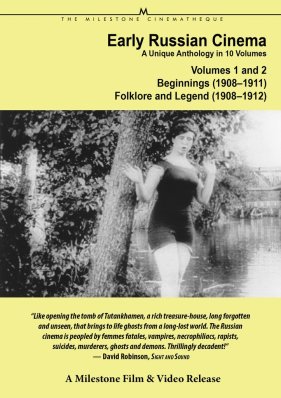Early Russian Cinema, Vol. 1 and 2: Beginnings/Folklore and Legend
Directed by Vladimir Romashkov, Kai Hansen, Maurice Maître, Vladimir Siversen, Vasili Goncharov
Early Russian Cinema, Volume 1: Beginnings
Sten’ka Razin (1908) has the distinction of being the first known Russian dramatic production. This account of a popular brigand leader who dallied with a captured Persian princess was adapted from a traditional ballad “From the Island to the Deep Stream”.
Princess Tarakanova (1910) marked the arrival of the film d’art formula in Russia. The film was based on a play about the martyred princess and boasted a cast of well-known actors.
Romance with a Double Bass (1911) is the first known cinematic interpretation of Chekhov’s works, excellently acted and further distinguished by the striking photography and beautiful locations in which the action takes place.
Early Russian Cinema, Volume 2: Folklore and Legend
Drama in a Gypsy Camp Near Moscow (1908) saw trend-setting production company Khanzhonkov recruit director Vladimir Siversen to capture scenarios on film using documentary techniques, shot entirely outdoors with unprecedented flair.
Rusalka (1910), based on Alexander Pushkin’s play about a prince and a mermaid, combines ornate style with handcrafted artistry to realize one of the most popular narratives of the time. The film’s effects and surreal underwater set are less typical of Russian productions and may reflect the concurrent popularity of trick films.
The Brigand Brothers (1912) features director Vasili Goncharov’s signature pantomime, superb locations around the Moscow River, and the debut of Russian icon Ivan Mozzhukhin, making it worthy of its lineage from one of Pushkin’s most epic poems.

